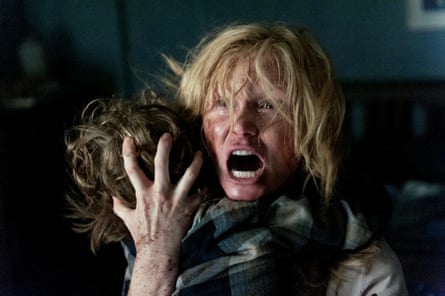His eyes are depthless pools, his mouth a taut rictus. His fingers taper to blade-like claws and he looms like a scarecrow. In the dark you might only make out his cheeks, a shock of bone-white puncturing the night. He is furry, hairy, a little scary. Or maybe he’s just misunderstood?
You know the Babadook even if you haven’t seen the film: Australian director Jennifer Kent’s ornate, expressionistic horror that premiered at Sundance in 2014 before becoming a household meme a few years later. The creature leaps from a menacing picture book to torment a single mother, Amelia (Essie Davis), and her son Sam (Noah Wiseman). The pair’s already spiky relationship grows increasingly terrifying as the monster invades their suburban abode. Will they banish him before he tears them apart for good?
The movie debuted to acclaim: the Guardian called it a “clever, nasty, clammily claustrophobic chiller”, while the New York Times exalted it as a “tour de force of maternal anguish”. For two years it remained a beloved (if under-seen) cult entry – until a viral 2016 Tumblr post labelled the Babadook a queer mascot. Suddenly, he was appearing at pride marches and parties and red carpets, spewing glitter from his demonic maw and brandishing rainbow flags in his talons.
For The Babadook’s 10th anniversary, we speak to the film’s driving forces about its origins, its success, and its unlikely afterlife.
-
Sign up for the fun stuff with our rundown of must-reads, pop culture and tips for the weekend, every Saturday morning
The beginning
Before The Babadook, there was Monster – Jennifer Kent’s 2005 short film which she developed into her feature over six months at Binger Filmlab, a workshop in Amsterdam.
Jennifer Kent, director: I had a friend [whose son] was three or four, and he was talking about seeing this monster man in his house. It was kind of obsessive and my friend was like, “What do I do?” So she just started pretending that it was real, and talking to it with her son. That’s how Monster came about. I had no intention whatsoever to write a feature version – but I wrote five or six feature scripts, and none of them were getting made. I thought: right, I need to go back to basics and make something very achievable, set in a house.
Kristina Ceyton, The Babadook producer and co-founder of Causeway Films: Jen and I met at a short film festival in Aspen [where] she had Monster playing. When she approached me [with The Babadook], I remember reading the first draft alone in the office and it was getting dark. It scared the bejeezus out of me. But not only that: I was really moved by this mother-son relationship.
Essie Davis, actor: Jen and I have been friends for ever. She was in the year above me at Nida [Sydney’s National Institute for Dramatic Art]. I remember reading the screenplay at the airport. I was waiting on the grass outside, and I was just turning the pages. Because I am a mother, I was very aware of the brutality of parenthood, but I was nervous about portraying a mother in that situation.
The child
The Babadook lives and dies by its central performance: the precocious, troubled Sam, played by then six-year-old Noah Wiseman. He was a natural.
Ceyton: We found him in this little after-school drama class. He was tiny, but he was really smart and connected. It was like casting the boy as well as his parents – his mum was a psychologist and I think she was initially quite wary.
Kent: I took him to the zoo and told him the story of The Babadook from Sam’s perspective. I said, he’s really the hero of this film, and he has to save his mum. I was really careful not to damage him psychologically or emotionally. He didn’t hear any of the swearing or see any really scary stuff – like Essie gliding towards the camera.
Davis: If you couldn’t see my mouth on camera, I would say completely different things; I’d say, “Go and eat dirt!” And then he would leave the room and I’d do the whole scene again with an adult stand-in on his knees.
In one sequence where I supposedly have a knife in my hand and I’m following him around, Noah whacked his elbow really badly. I could see tears come into his eyes. [I said] “We gotta use it. Noah, use it!” He kept on going, and he was so proud of using that accidental pain in the scene. He was jumping for joy at the end. Not that I’m advocating that you have to injure yourself …
Kent: At one point, he had to get really angry. When I yelled cut, he stood up and he said, “I was really good!” And then he went around telling everyone at lunch how good he was. I thought, imagine an adult actor doing that. But he was good and he recognised it.
When we wrapped, he jumped into my arms and said, “It’s not really over, is it?” I thought, if the film sucks, at least I’ve had this beautiful relationship with the cast.
The shoot
They had US$2m and a dream. The film was designed within an inch of its life; everything from the house to the storybook had to look perfectly gothic on a shoestring. And so the crew went to Adelaide for a very frenetic, very DIY six-week shoot.
Kent: It was such a trial by fire. We were all a bit green and terrified.
Ceyton: Everything was low-budget. Making a film is like giving birth: it’s horrendous, but then you sort of forget [how hard it was].
Kent: The film goes from muted colours to almost black-and-white. I would say, “The grass is too green!” – because we weren’t allowing green in the colour, and the cinematographer would just laugh. We had to grey-wash all the brown furniture so it wasn’t as brown.
Ceyton: The colour scheme was a freaking nightmare.
In a scene during the film’s climax, single mother Amelia becomes possessed by the Babadook and begins wreaking havoc – including, controversially, offing the family dog.
Ceyton: We found this woman who had this amazing little dog who was already trained. But then we had to kill the dog. We found someone in Melbourne [to make a prop dog] but he had a pre-cast of another dog; we couldn’t get the same breed. The guy turns up on set the day before and it’s three times the size. It was like a German shepherd. So the poor guy had to be up til three in the morning trying to make it as small as possible.
You know how many people said “don’t kill the dog”? But at least no person dies! Someone’s gotta die, otherwise the threats aren’t there. You have to kill the dog!
after newsletter promotion
The monster
It was three weeks out from the shoot and they hadn’t found an actor for the Babadook himself. They ended up enlisting the tallest man on set.
Ceyton: We had a friend of ours play the Babadook. I think that’s his only screen credit on IMDb. His name is Tim Purcell, and he’s an old friend of Alex [Holmes, the production designer and Ceyton’s husband].
Tim Purcell, the Babadook: I’d just got out of a relationship. I rang up [Kristina and Alex] and I said, I’m packing my car and driving down to South Australia. I didn’t even ask them. I was basically assisting Alex with squillions of things: building the whole house on set, ageing wallpaper, I made the Babadook’s claws.
They wanted to do this stop-motion stuff with the Babadook, and they were going to hire a body movement actor for $15,000. I was there and I’m six foot seven. I had just done three months of hot yoga after the end of my relationship. The visual effects guy was like, “Why don’t you just get your friend to do it?”
When the shooting started, I got dressed up and harnessed to a ceiling. I had this mouth prosthetic in so I literally couldn’t control the drool out of my mouth. I’m in the film for all of 1.3 seconds.
Kent: We just needed the tallest, lankiest guy who was prepared to stay in positions for a long time.
The runaway success
If the shoot was difficult, then what came next – the feedback from funders and test audiences – was even worse. But against all odds, the film was a hit.
Ceyton: At one test screening, people were invited to give feedback, and it was so awful and so negative.
Kent: Everyone from [government film funding agency] Screen Australia hated it. My editor did a version with all the bits that no one wanted to give feedback on and it was literally, like, 45 seconds.
Davis: The first time I saw it I remember thinking: what a shame, it’s not scary, right? Then we went to Sundance, and I was sitting in the back row watching the audience leaping out of their seats and jumping up and down. The volume of the reaction! Afterwards, guys in their 60s with handlebar mos and leather jackets were coming up and going, “That’s the story of me and my mum.” And teenage girls. It was this weird spectrum of reaching so many people.
Ceyton: There was a real buzz during Sundance. But it could’ve gone either way, right? I had no idea if people were gonna hate it or love it. And then within hours of the release, we had mostly positive reviews come out. That was a huge relief.
Kent: I measure the success of something by the response I get back personally. I had one young man say he was the son of a single mother, and his father died when he was seven. He said The Babadook was so profound for him, it was better than 20 years of therapy. There was a librarian who’d lost his young wife and wrote me a really beautiful email. And [The Exorcist director] William Friedkin wrote to me and put on a screening at his local cinema in LA.
The queer icon
“Whenever someone says the Babadook isn’t openly gay it’s like?? Did you even watch the movie???” So went the tongue-in-cheek 2016 Tumblr post that garnered close to 100,000 responses. A screenshot soon after showing the film categorised under “LGBT movies” on Netflix – either a coding error or more likely a doctored meme – catapulted the Babadook into queer infamy. He became the little demon that could, inspiring drag queens, many, many pride mascots, and at least one hapless Halloween costume.
Purcell: I was living in Bondi [when the Babadook went viral]. I agreed to an interview with the New York Times, and I got the time wrong. I thought it was three in the afternoon but it was three in the morning. I was having a party at my place and I took this call – I spoke to this person for probably 40 minutes and I have no idea what I said. They asked me what it’s like to be a gay icon, and I said, “It’s fabulous.”
Kent: One of my favourite shows is RuPaul’s Drag Race, and I remember seeing some reference to it on the show. I was like, oh my god, I’ve made it. I can die happily now. I love that The Babadook is in the Urban Dictionary because I feel quite vindicated. I was told by everyone who had a mouth, “You cannot call your film The Babadook, that’s such a stupid title and no one will remember it.” And I was like, OK, whatever.
Ceyton: The Babadook was in parades and on dildos! We were offered a best queer film award and we said, I think this should go to someone else. It was obviously not the intention – but it was an honour that queerness can be read into it.
Kent: He’s in the closet! But hopefully he comes out of the closet. He dresses well, all the cliches. I’m proud of that little bastard.
-
Interviews have been edited and condensed for clarity.
Source: theguardian.com


















